Collection Editor in WPF PropertyGrid
7 May 202124 minutes to read
You can edit (add, remove) a collection type of property such as List, ObservableCollection using the Collection Editor in the PropertyGrid.
How to add or remove items in collection using collection editor
You can add or remove the new items into the collection type properties by clicking the Add or Remove button. If you want to add the items into SelectedObject collection, you must click the Ok button to update the added items into the collection, otherwise it is not updated.
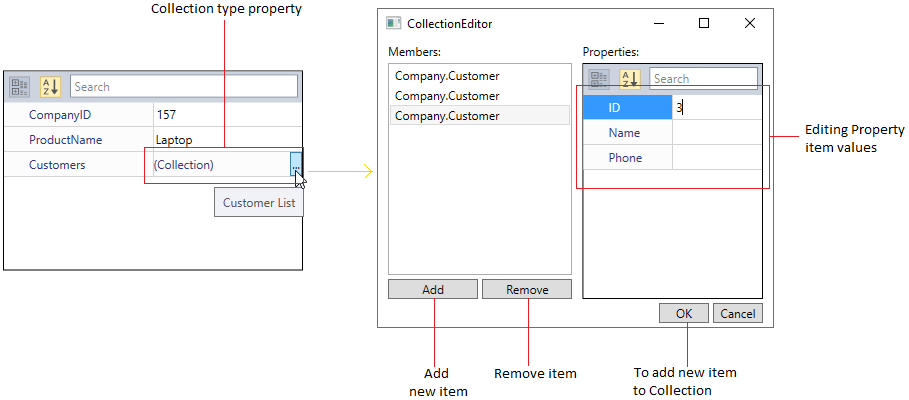
NOTE
Collection type property must be derived from the
IListtype to edit the collection properties in theSelectedObject. TheIListcollection property must contain the non-parameter constructor to edit the items in the collection, otherwise only the items in the collection property can be removed.
NOTE
You will not be able to edit a collection of primitive type, such as
List<int>andList<string>.
Edit a selected object, which is of type collection
If you directly assign the collection instance as SelectedObject, it generates value editor for the each collection property items.
public class Persons {
public string Name { get; set; }
public string Address { get; set; }
public override string ToString() {
return Name;
}
}
public class ViewModel {
private ObservableCollection<Person> persons = new ObservableCollection<Person>();
public ObservableCollection<Person> Persons {
get {
return persons;
}
set {
persons = value;
}
}
public ViewModel() {
persons.Add(new Person() { Name = "Mark", Address = "United States" });
persons.Add(new Person() { Name = "Smith", Address = "United States" });
}
}<syncfusion:PropertyGrid PropertyExpandMode="NestedMode"
SelectedObject="{Binding Persons}"
x:Name="propertyGrid">
<syncfusion:PropertyGrid.DataContext>
<local:ViewModel></local:ViewModel>
</syncfusion:PropertyGrid.DataContext>
</syncfusion:PropertyGrid>PropertyGrid propertyGrid = new PropertyGrid();
propertyGrid.DataContext = new ViewModel();
propertyGrid.SetBinding(PropertyGrid.SelectedObjectProperty, new Binding("Persons"));
propertyGrid1.PropertyExpandMode = PropertyExpandModes.NestedMode;
NOTE
View Sample on GitHub
Edit a selected object, which has a property of type collection.
You can add, remove or edit the collection type property item by using the Collection Editor.
public class Customer {
public int ID { get; set; }
public string Name { get; set; }
public string Phone { get; set; }
}
public class Employee {
public int ID { get; set; }
public string Name { get; set; }
public string Phone { get; set; }
}
public class CustomerCollection : ObservableCollection<Customer> {
public CustomerCollection() { }
public override string ToString() {
return "Customer List";
}
}
public class EmployeeList : List<Employee> {
public EmployeeList() { }
public override string ToString() {
return "Employee List";
}
}
public class Product {
public int CompanyID { get; set; }
public string ProductName { get; set; }
public CustomerCollection Customers { get; set; }
public EmployeeList Employees { get; set; }
}
public class ViewModel {
public Product DemoProduct { get; set; }
public ViewModel() {
DemoProduct = new Product()
{
CompanyID = 157,
ProductName = "Laptop",
Customers = new CustomerCollection
{
new Customer() { ID = 0, Name = "John", Phone = "2065349857" },
new Customer() { ID = 1, Name = "Peter", Phone = "2065981189" }
},
Employees = new EmployeeList
{
new Employee() { ID = 0, Name = "Mark", Phone = "2065489864" },
new Employee() { ID = 1, Name = "David", Phone = "2063481135" }
}
};
}
}<syncfusion:PropertyGrid SelectedObject="{Binding DemoProduct}"
x:Name="propertyGrid">
<syncfusion:PropertyGrid.DataContext>
<local:ViewModel></local:ViewModel>
</syncfusion:PropertyGrid.DataContext>
</syncfusion:PropertyGrid>PropertyGrid propertyGrid = new PropertyGrid();
propertyGrid.DataContext = new ViewModel();
propertyGrid.SetBinding(PropertyGrid.SelectedObjectProperty, new Binding("DemoProduct"));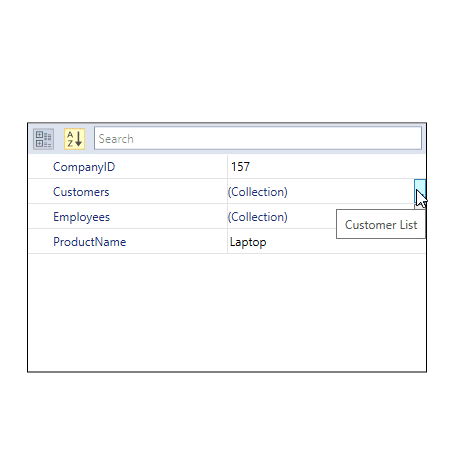
NOTE
View Sample on GitHub
Collection Editor for nested collection property
You can update the nested collection property item by using the Collection Editor.

public class AddressDetails {
public int DoorNo { get; set; }
public string City { get; set; }
}
public class Supplier {
public int ID { get; set; }
public string Name { get; set; }
public string Phone { get; set; }
public ObservableCollection<AddressDetails> Address { get; set; }
}
public class SupplierList : List<Supplier> {
public SupplierList() : base() { }
public override string ToString()
{
return "Supplier List";
}
}
public class Product {
public int ID { get; set; }
public string ProductName { get; set; }
public SupplierList Suppliers { get; set; }
}
public ViewModel() {
DemoProduct = new Product() {
ID = 0,
ProductName = "Office Table",
Suppliers = new SupplierList
{
new Supplier()
{
ID = 0,
Name = "Jack Plank",
Phone = "2065559857",
Address = new ObservableCollection<AddressDetails>()
{
new AddressDetails
{
City="Mexico",
DoorNo=456
}
}
}
}
};
}<syncfusion:PropertyGrid SelectedObject="{Binding DemoProduct}"
x:Name="propertyGrid">
<syncfusion:PropertyGrid.DataContext>
<local:ViewModel></local:ViewModel>
</syncfusion:PropertyGrid.DataContext>
</syncfusion:PropertyGrid>PropertyGrid propertyGrid = new PropertyGrid();
propertyGrid.DataContext = new ViewModel();
propertyGrid.SetBinding(PropertyGrid.SelectedObjectProperty, new Binding("DemoProduct"));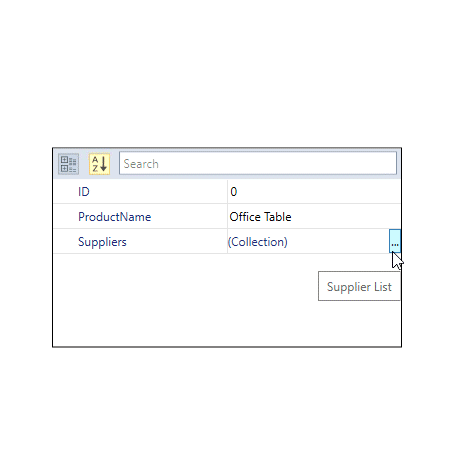
NOTE
View Sample on GitHub
Readonly mode for collection type properties
If you want to restrict the user to add or remove the items in the collection type properties, handle the CollectionEditorOpening event and set the CollectionEditorOpeningEventArgs.IsReadonly property value as true. The default value of CollectionEditorOpeningEventArgs.IsReadonly property is false.
NOTE
You will not be able to add or remove the items into the collection type properties. But, you can edit and save the existing items that are available in the collection type properties.
public class Customer {
public int ID { get; set; }
public string Name { get; set; }
public string Phone { get; set; }
}
public class Employee {
public int ID { get; set; }
public string Name { get; set; }
public string Phone { get; set; }
}
public class CustomerCollection : ObservableCollection<Customer> {
public CustomerCollection() { }
public override string ToString() {
return "Customer List";
}
}
public class EmployeeList : List<Employee> {
public EmployeeList() { }
public override string ToString() {
return "Employee List";
}
}
public class Product {
public int CompanyID { get; set; }
public string ProductName { get; set; }
public CustomerCollection Customers { get; set; }
public EmployeeList Employees { get; set; }
}
public class ViewModel {
public Product DemoProduct { get; set; }
public ViewModel() {
DemoProduct = new Product()
{
CompanyID = 157,
ProductName = "Laptop",
Customers = new CustomerCollection
{
new Customer() { ID = 0, Name = "John", Phone = "2065349857" },
new Customer() { ID = 1, Name = "Peter", Phone = "2065981189" }
},
Employees = new EmployeeList
{
new Employee() { ID = 0, Name = "Mark", Phone = "2065489864" },
new Employee() { ID = 1, Name = "David", Phone = "2063481135" }
}
};
}
}<syncfusion:PropertyGrid CollectionEditorOpening="propertyGrid_CollectionEditorOpening"
SelectedObject="{Binding DemoProduct}"
x:Name="propertyGrid">
<syncfusion:PropertyGrid.DataContext>
<local:ViewModel></local:ViewModel>
</syncfusion:PropertyGrid.DataContext>
</syncfusion:PropertyGrid>PropertyGrid propertyGrid = new PropertyGrid();
propertyGrid.DataContext = new ViewModel();
propertyGrid.SetBinding(PropertyGrid.SelectedObjectProperty, new Binding("DemoProduct"));
propertyGrid.CollectionEditorOpening += propertyGrid_CollectionEditorOpening;You can handle the CollectionEditorOpening event as follows,
private void propertyGrid_CollectionEditorOpening(object sender, CollectionEditorOpeningEventArgs e)
{
//Enabling the readonly collection editor
e.IsReadonly = true;
}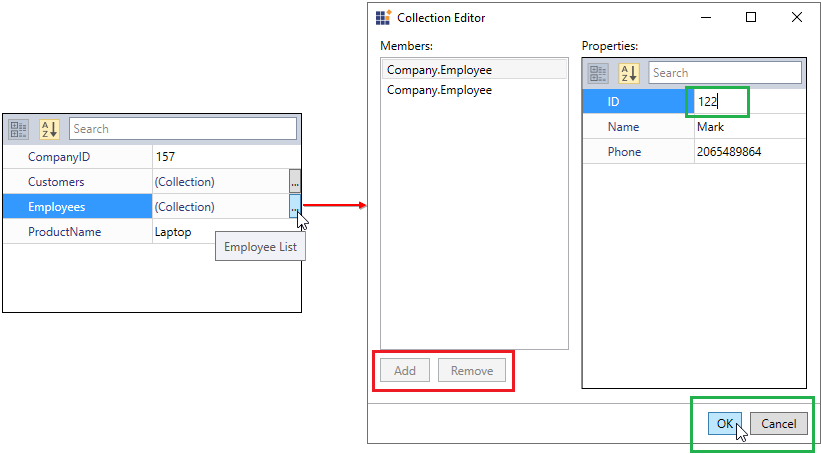
Here, Add and Remove buttons are disabled. Ok and Cancel button are enabled to edit the existing item values.
NOTE
Readonly mode for specific property of collection type
If you want to restrict the user to add or remove the items in the specific property of collection type, create that collection property as the type of ReadOnlyCollection.
NOTE
You will not be able to add or remove the items into the readonly collection type properties. But, you can edit and save the existing items that are available in the readonly collection type properties.
public class Customer
{
public int ID { get; set; }
public string Name { get; set; }
public string Phone { get; set; }
}
public class Employee
{
public int ID { get; set; }
public string Name { get; set; }
public string Phone { get; set; }
}
public class Product
{
public int CompanyID { get; set; }
public string ProductName { get; set; }
public List<Employee> Employees { get; set; }
internal List<Customer> customers;
public ReadOnlyCollection<Customer> Customers
{
get
{
return customers.AsReadOnly();
}
}
}
public class ViewModel
{
public Product DemoProduct { get; set; }
public ViewModel()
{
DemoProduct = new Product()
{
CompanyID = 157,
ProductName = "Laptop",
customers = new List<Customer>
{
new Customer() { ID = 0, Name = "John", Phone = "2065349857" },
new Customer() { ID = 1, Name = "Peter", Phone = "2065981189" }
},
Employees = new List<Employee>()
{
new Employee() { ID = 0, Name = "Mark", Phone = "2065489864" },
new Employee() { ID = 1, Name = "David", Phone = "2063481135" }
}
};
}
}<syncfusion:PropertyGrid SelectedObject="{Binding DemoProduct}"
x:Name="propertyGrid">
<syncfusion:PropertyGrid.DataContext>
<local:ViewModel></local:ViewModel>
</syncfusion:PropertyGrid.DataContext>
</syncfusion:PropertyGrid>PropertyGrid propertyGrid = new PropertyGrid();
propertyGrid.DataContext = new ViewModel();
propertyGrid.SetBinding(PropertyGrid.SelectedObjectProperty, new Binding("DemoProduct"));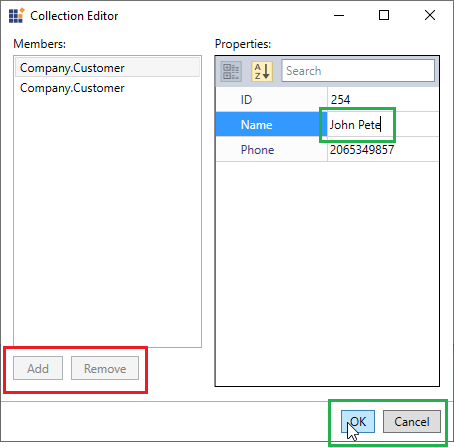
Here, Customers property is a readonly collection type property. So, you will not be able to add or remove the items into the Customers property.
NOTE
Restrict the collection editor from opening
You can restrict the opening of collection editor window which used to edit the collection type properties in PropertyGrid by handling the CollectionEditorOpening event and set the CollectionEditorOpeningEventArgs.Cancel property value as true. The default value of CollectionEditorOpeningEventArgs.Cancel property is false.
public class Customer {
public int ID { get; set; }
public string Name { get; set; }
public string Phone { get; set; }
}
public class Employee {
public int ID { get; set; }
public string Name { get; set; }
public string Phone { get; set; }
}
public class CustomerCollection : ObservableCollection<Customer> {
public CustomerCollection() { }
public override string ToString() {
return "Customer List";
}
}
public class EmployeeList : List<Employee> {
public EmployeeList() { }
public override string ToString() {
return "Employee List";
}
}
public class Product {
public int CompanyID { get; set; }
public string ProductName { get; set; }
public CustomerCollection Customers { get; set; }
public EmployeeList Employees { get; set; }
}
public class ViewModel {
public Product DemoProduct { get; set; }
public ViewModel() {
DemoProduct = new Product()
{
CompanyID = 157,
ProductName = "Laptop",
Customers = new CustomerCollection
{
new Customer() { ID = 0, Name = "John", Phone = "2065349857" },
new Customer() { ID = 1, Name = "Peter", Phone = "2065981189" }
},
Employees = new EmployeeList
{
new Employee() { ID = 0, Name = "Mark", Phone = "2065489864" },
new Employee() { ID = 1, Name = "David", Phone = "2063481135" }
}
};
}
}<syncfusion:PropertyGrid CollectionEditorOpening="propertyGrid_CollectionEditorOpening"
SelectedObject="{Binding DemoProduct}"
x:Name="propertyGrid">
<syncfusion:PropertyGrid.DataContext>
<local:ViewModel></local:ViewModel>
</syncfusion:PropertyGrid.DataContext>
</syncfusion:PropertyGrid>PropertyGrid propertyGrid = new PropertyGrid();
propertyGrid.DataContext = new ViewModel();
propertyGrid.SetBinding(PropertyGrid.SelectedObjectProperty, new Binding("DemoProduct"));
propertyGrid.CollectionEditorOpening += propertyGrid_CollectionEditorOpening;You can handle the CollectionEditorOpening event as follows,
private void propertyGrid_CollectionEditorOpening(object sender, CollectionEditorOpeningEventArgs e)
{
//Restrict collection editor window opening
e.Cancel = false;
}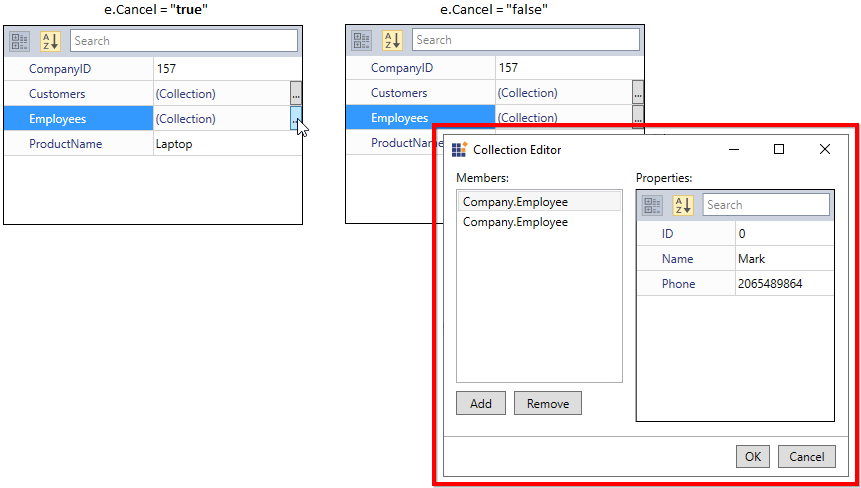
NOTE